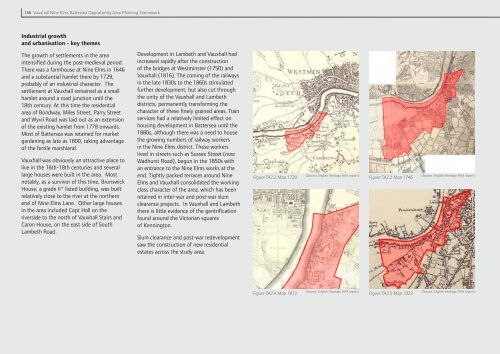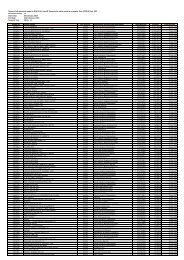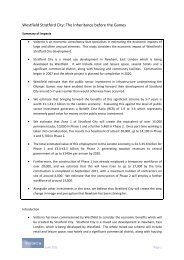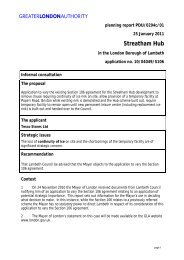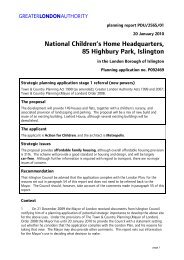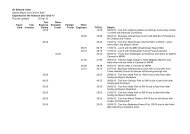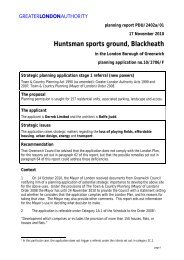Vauxhall Nine Elms Battersea Opportunity Area Planning Framework
Vauxhall Nine Elms Battersea Opportunity Area Planning Framework
Vauxhall Nine Elms Battersea Opportunity Area Planning Framework
Create successful ePaper yourself
Turn your PDF publications into a flip-book with our unique Google optimized e-Paper software.
180 <strong>Vauxhall</strong> <strong>Nine</strong> <strong>Elms</strong> <strong>Battersea</strong> <strong>Opportunity</strong> <strong>Area</strong> <strong>Planning</strong> <strong>Framework</strong>Industrial growthand urbanisation - key themesThe growth of settlements in the areaintensified during the post-medieval period.There was a farmhouse at <strong>Nine</strong> <strong>Elms</strong> in 1646and a substantial hamlet there by 1729,probably of an industrial character. Thesettlement at <strong>Vauxhall</strong> remained as a smallhamlet around a road junction until the18th century. At this time the residentialarea of Bondway, Miles Street, Parry Streetand Wyvil Road was laid out as an extensionof the existing hamlet from 1778 onwards.Most of <strong>Battersea</strong> was retained for marketgardening as late as 1800, taking advantageof the fertile marshland.<strong>Vauxhall</strong> was obviously an attractive place tolive in the 16th-18th centuries and severallarge houses were built in the area. Mostnotably, as a survivor of this time, BrunswickHouse, a grade II* listed building, was builtrelatively close to the river at the northernend of <strong>Nine</strong> <strong>Elms</strong> Lane. Other large housesin the area included Copt Hall on theriverside to the north of <strong>Vauxhall</strong> Stairs andCaron House, on the east side of SouthLambeth Road.Development in Lambeth and <strong>Vauxhall</strong> hadincreased rapidly after the constructionof the bridges at Westminster (1750) and<strong>Vauxhall</strong> (1816). The coming of the railwaysin the late 1830s to the 1860s stimulatedfurther development, but also cut throughthe unity of the <strong>Vauxhall</strong> and Lambethdistricts, permanently transforming thecharacter of these finely grained areas. Trainservices had a relatively limited effect onhousing development in <strong>Battersea</strong> until the1880s, although there was a need to housethe growing numbers of railway workersin the <strong>Nine</strong> <strong>Elms</strong> district. These workerslived in streets such as Sussex Street (nowWadhurst Road), begun in the 1850s withan entrance to the <strong>Nine</strong> <strong>Elms</strong> works at theend. Tightly packed terraces around <strong>Nine</strong><strong>Elms</strong> and <strong>Vauxhall</strong> consolidated the workingclass character of the area, which has beenretained in inter-war and post-war slumclearance projects. In <strong>Vauxhall</strong> and Lambeththere is little evidence of the gentrificationfound around the Victorian squaresof Kennington.Slum clearance and post-war redevelopmentsaw the construction of new residentialestates across the study area.(Source: English Heritage HAA report)Figure TA2.2 Map 1729 Figure TA2.3 Map 1746(Source: English Heritage HAA report)(Source: English Heritage HAA report)Figure TA2.4 Map 1813 Figure TA2.5 Map 1823(Source: English Heritage HAA report)


